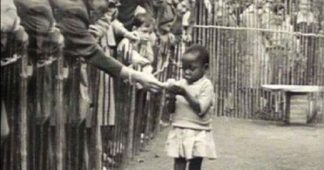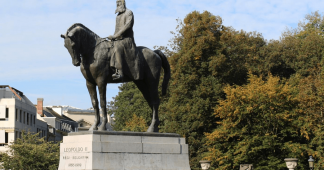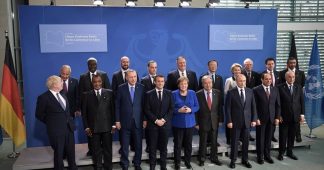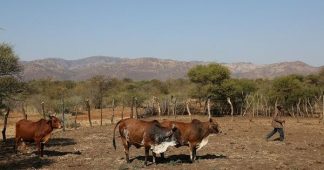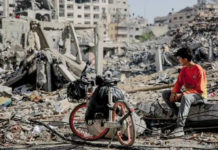By Jeremy Kuzmarov
A new book reveals how U.S. Presidents of both parties unleashed the CIA in the Congo to do the dirty work of greedy corporations, causing misery, mutilations and massacres of such magnitude they dwarfed even the wildest accounts depicted in Joseph Conrad’s Heart of Darkness.
On June 30, 2020, 60 years after the Democratic Republic of Congo (DRC) first achieved its independence from Belgium, author Justin Podur envisions a 95-year old Patrice Lumumba giving a speech celebrating the creation of a successful democracy in the heart of Africa that has used its immense mineral wealth to build a high-tech manufacturing base, while helping to avert ethnic conflict in neighboring countries.
In real life, Patrice Lumumba was assassinated in February 1961 in a plot supported by the Central Intelligence Agency (CIA).
Podur’s book, America’s Wars on Democracy in Rwanda and the DR Congo (New York: Palgrave Macmillan, 2020), juxtaposes the bright future that Lumumba promised as the DRC’s first prime minister with the dark history of what actually happened.
After Lumumba was killed, the U.S. government lavished hundreds of millions of dollars in aid to help consolidate the power of his former army chief of staff and assassin Joseph Mobutu, who stole millions of dollars from the public treasury over the next 30 years, killed thousands of people, and wrecked any prospects for the DRC’s successful development.
When Mobutu fell ill with cancer and lost his strategic utility in the 1990s, the U.S. had him replaced and sponsored a joint Rwandan-Ugandan invasion of the DRC that caused millions more deaths and resulted in further looting of Congo’s resources.

Congo’s Tortured History
Congo’s tortured modern history began when the country was colonized by the Belgian King Leopold.
The cruelty of the Belgian colonial agents was memorialized in Joseph Conrad’s book, Heart of Darkness (1899), which centered on the journey of a Belgian trader who witnesses gruesome atrocities as the locals are put to work in the service of the colonial masters.
Podur’s book shows how colonialist attitudes, along with predatory economic practices, have continued into the 21st century accompanied by horrific violence, which would have even shocked Conrad.
In some of his best chapters, Podur takes to task academic specialists and journalists for reinforcing a colonialist discourse by denying the negative impact of Western intervention and by promoting stereotypes implying that Africans cannot govern themselves effectively.
Some of these writers repeat CIA disinformation about Lumumba’s allegedly voracious sexual appetite, and imply that Lumumba would have inevitably evolved as a dictator if he had lived. They also obscure that American intervention in Central Africa has long been undergirded by economic motives.
In 1963, U.S. private investment in the Congolese mining industry reached $1.2 billion. The Rockefellers had holdings in the Congolese bauxite industry and the Katanga mining company, as did American Metal Climax and Templesman & Sons, a diamond trading company, which employed the CIA station chief in the DRC, Lawrence Devlin, as a private consultant.

Believing that real democracy in the Congo was “unattainable,” Devlin helped coordinate the suppression of the Simba revolt led by pro-Lumumba forces after Mobutu’s power was consolidated. The Simba were supported by the Argentine revolutionary Che Guevara, who traveled to the DRC to provide training in guerrilla warfare techniques.
To fight the Simba, the CIA helped mobilize white mercenaries who committed horrific atrocities reminiscent of the U.S. army in Vietnam. A French mercenary told AP News that “[Congolese] people don’t like us. We get good pay for killing women and children.”
The Simba war of the 1960s set the groundwork for the Congo wars of the 1990s, which were instigated by U.S. proxy forces in Rwanda and Uganda who committed yet more atrocities.
The Clinton administration followed precedent by transferring military vehicles and providing aerial reconnaissance and radio intelligence. U.S. military attaché Peter Waley, was in such close contact with the new DRC leader, Laurent Kabila, who supported the Rwandan and Ugandan invasions, that the conflict became known as “Waley’s war.”
Supporting Another Monster
If Mobutu was the U.S.’s favored client during the Cold War, Rwandan dictator Paul Kagame has fit the designation ever since. During his quarter-century in power, he has been lavished with honorary degrees from Harvard, named as one of Time Magazine’s most influential people, and lauded by Bill Clinton as “one of the greatest leaders of our time.” Journalist Stephen Kinzer compared Kagame to Abraham Lincoln and described his 1996 invasion of the DRC as “one of the most remarkable military campaigns in modern African history.”
According to Podur, Kagame is actually one of the most outstanding mass murderers of our time. He has developed a global assassination machine to kill off rivals while advancing a phony narrative about the genocide in Rwanda, which has been bought hook line and sinker by his naive admirers.
In October 1990, as leader of the Tutsi-led Rwandan Patriotic Front (RPF) in Uganda, Kagame helped plan the invasion of Rwanda in an attempt to overthrow the Hutu-led government of Juvenal Habyarimana, and oversaw mass killings that made use of open-air crematoria to dispose of the bodies efficiently.
On April 6, 1994, according to various investigations, Kagame ordered the shooting down of Habyarimana’s airplane, which led to the mobilization of Hutu militias (Interhamwe) in an attempt to save Rwanda from RPF takeover. Habyarimana had just signed the Arusha accords instituting a power-sharing arrangement and establishing free elections, which Kagame knew he would lose.
To punish the Hutu population after the RPF’s military victory, Kagame set up a draconian prison system whose inmates died like flies in overcrowded cells. The RPF at the same time hunted down Hutu refugees in Eastern Congo, and systematically looted its mineral resources in order to finance Kagame’s military machine.
The U.S. has stood by Kagame during his reign of terror because he welcomes private investors and invaded the DRC twice in support of Western interests. One of the main beneficiaries of the Congo Wars was the copper giant Phelps Dodge, which secured ownership of the cobalt-producing Temke-Fungunume mine with the help of the U.S. embassy.
No Mere Bystander to Genocide
Rwanda’s political troubles are rooted in the Belgian colonial order. As part of their strategy of divide and rule, the Belgians elevated a Tutsi aristocracy, which was overthrown after Rwanda achieved independence in 1962. When Hutu seminarian Grégoire Kayibinda became head of state, the Tutsi tried to reclaim their former privileged status, and many were expelled into neighboring countries and others massacred.
During the 1980s, Paul Kagame and other Tutsi exiles supported Ugandan leader Yoweri Museveni’s guerrilla forces as they fought a bush war in an attempt to unseat President Milton Obote (1966, 1971; 1980-1985). Kagame and the RPF subsequently applied military tactics—including gruesome torture techniques and the art of political assassination—that they learned in their wars in Rwanda and the DRC. Kagame never forgot how the tide in the bush war turned when one of Obote’s top commanders, David Oyite-Ojok, had his helicopter shot down.
When Tutsi officers who had assisted Museveni’s rise to power were demoted in the late 1980s, they realized that the time had come for them to return to Rwanda through armed struggle. A dispute erupted at that point between Kagame and RPF commander Fred Rwigyema, who wanted to proceed with the invasion of Rwanda cautiously, to first politicize the peasantry and get their rural masses on the RPF side.
According to Podur, Rwigyema was a “brilliant man whose combination of royal legitimacy and revolutionary charisma made him a probable future national leader.” Unfortunately, Rwigyema was shot and killed by one of Kagame’s confidantes. Abdul Ruzibiza, an RPF veteran, stated that “Kagame [now] found himself at the head of an army that did not accept him. He maintained his rule through terror, assassination, imprisonment and executions.”
Prior to his death, Rwigyema had been selected by Museveni to attend an officers’ course at Fort Leavenworth, Kansas. Kagame went in his place and was trained in the art of psychological warfare and other counterinsurgency tactics. In his spare time, Kagame helped plot the Rwandan invasion in phone calls with Rwigyema that were likely monitored by his hosts. American assistance to the RPF at the time was being laundered through Uganda, which purchased ten times more weapons in 1991 than in the preceding 40 years combined.
The April 1994 genocide took place within the context of Rwanda’s civil war triggered by the RPF’s 1990 invasion from Uganda. According to the latest independent research, more Hutu were killed than Tutsi, many by RPF forces who sacrificed the local population in their bid for political power.
Podur’s book effectively challenges the official narrative and myth that the U.S. was a “bystander to genocide,” as former U.S. ambassador to the UN Samantha Power framed it in her Pulitzer prize winning book, A Problem from Hell: America in the Age of Genocide (2003).
Power leaves out mention of the RPF’s destabilizing invasion of Rwanda and how the U.S. helped Kagame to gain state power.
After the RPF victory, U.S. troops arrived to support Kagame’s new government and stayed until the end of September 1994. The Clinton administration further called back UN troops, which might have impeded the RPF victory, and encouraged UN mission chief Romeo Dallaire while he worked to disarm the Hutu government forces and allowed weapons to flow to the RPF through the Ugandan border.
In 1995, U.S. Defense Secretary William J. Perry visited with Kagame and helped broker an expansion of military training and intelligence-sharing operations while supporting the lifting of an international arms embargo to the RPF regime.
The Clinton administration subsequently increased its military assistance and provided political cover as Rwanda invaded and plundered the DRC.
Western academics and media pundits demonized the entire Hutu population and lent support to the Rwandan government’s argument that they were all génocidaires who had to be hunted down and killed.
In fact, only a small percentage of Hutu had carried out killings in the spring of 1994. Thousands of women and children were among those slaughtered or forced into squalid refugee camps where they died from starvation and disease outbreaks.
Massacres carried out by Rwandese militias backed by the Congolese army continue to this day as the U.S. lavishes military and economic aid on Rwanda while protecting Kagame from prosecution for his crimes.
Although the United States may conceive of itself as “the indispensable nation,” Podur’s study shows it to be an heir to the colonial powers. Under successive administrations, it has sustained racialist discourse and stereotypes as a means of justifying naked economic exploitation, sordid military alliances, and shameful atrocities. Most egregious has been the demonization of an entire ethnic group, the Hutu, in a manner that lent justification to their attempted extermination.
Podur’s book is significant in one other important respect: He has reminded us about the positive historical legacy of Patrice Lumumba, who stood against colonial depredations, for African control over its economy and resources, and for the healing of ethnic divisions. Though Lumumba was killed prematurely, his vision will continue to resonate in the coming era when a weakened West can no longer wreak the same kind of havoc that it has in the past, and where Conrad’s dystopia, with hope, may finally be brought to an end.
* Jeremy Kuzmarov is Managing Editor of CovertAction Magazine and author of four books on U.S. foreign policy, including Obama’s Unending Wars (Atlanta: Clarity Press, 2019).
Published at covertactionmagazine.com
